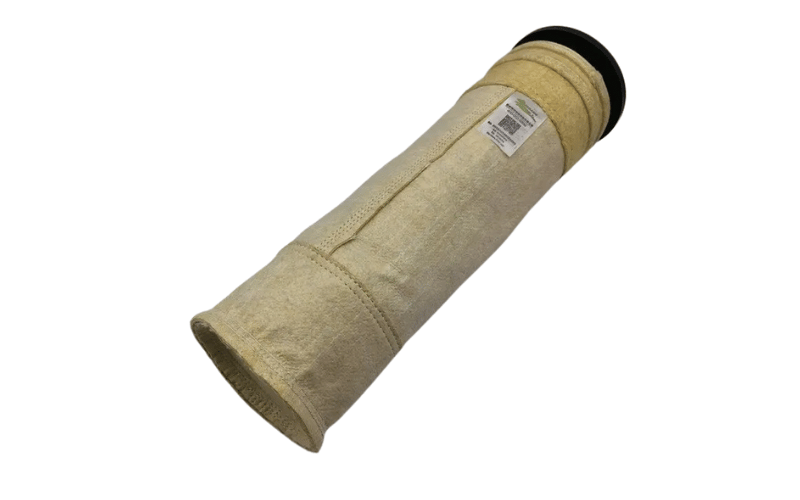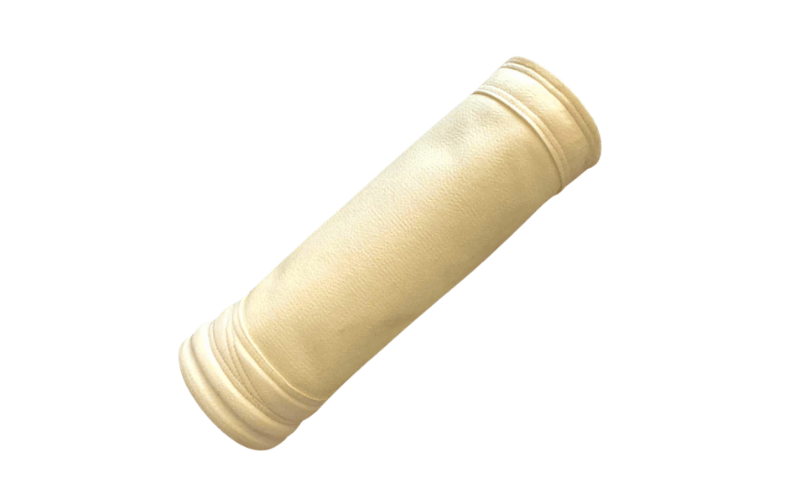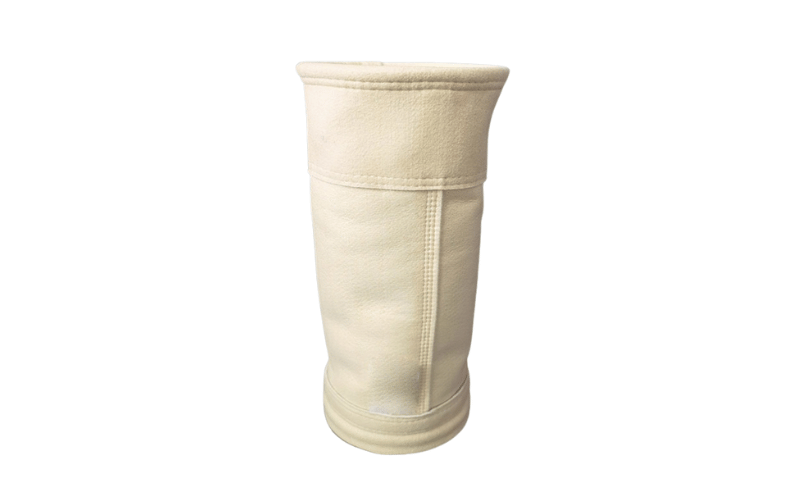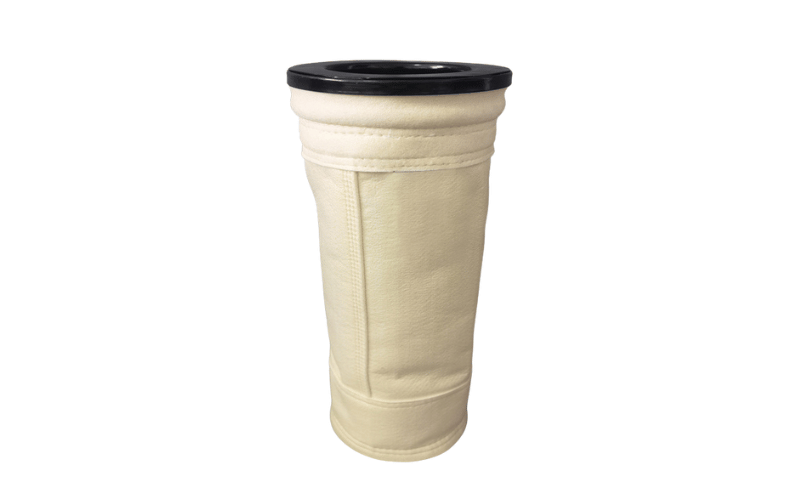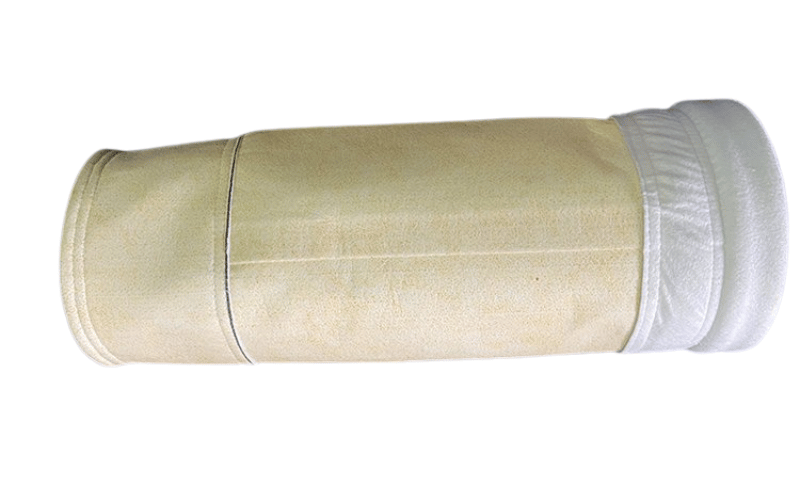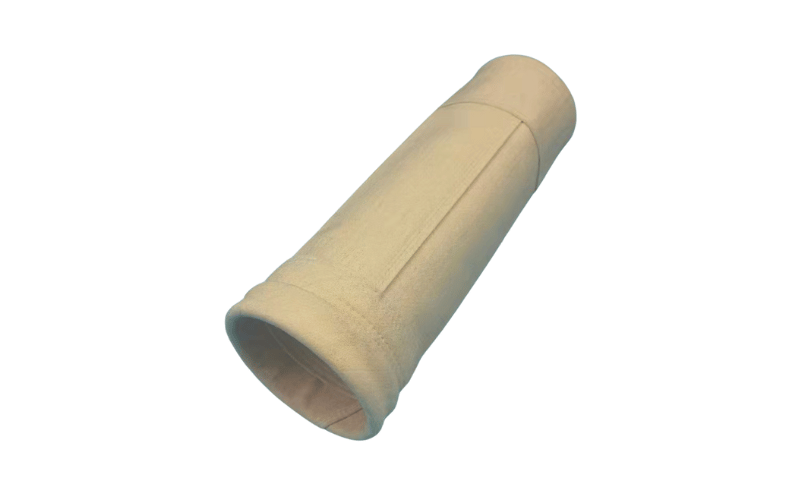Acrylic Filter Bag
Home » Dust Filter Bag » Acrylic Filter Bag
Efficient Filtration | Long Service Life | Customizable Options
Acrylic filter bags are crafted through a non-woven needle-punched process, featuring acrylic fibers with robust interlaced structures and uniformly distributed fine fibers. The surface is treated with thermal calendering and singeing, resulting in a smooth, flat surface that effectively resists dust blockage. This advanced design ensures large pores, excellent air permeability, and strong chemical stability, making them ideal for filtering both ambient temperature gases and medium-temperature gases up to 150°C.
Acrylic filter bags excel in filtering acidic and alkaline corrosive gases, positioning them as a reliable choice for challenging environments. Compared to polyester needle-punched felt, acrylic offers superior resistance to hydrolysis, enabling it to maintain its integrity and performance in moisture-rich or high-humidity environments.
Key Features and Benefits
High Performance
Large pores and excellent air permeability enable efficient gas filtration with minimal pressure drop.Superior Hydrolysis Resistance
Outperforms polyester materials in resisting degradation caused by moisture, ensuring durability in high-humidity environments.Chemical Stability
Designed to handle acidic and alkaline corrosive gases safely and effectively.Versatile Operating Temperature
Suitable for filtering ambient temperature gases as well as medium-temperature gases up to 150°C.
Technical Specifications
| Parameter | Specification |
|---|---|
| Name | Acrylic Filter Bag |
| Material | Acrylic Fiber/Acrylic Base Cloth |
| Weight | 500g/M² |
| Air Permeability | 80-100m³/M²/S |
| Warp Tension | >110 N/5x20cm |
| Weft Tension | >900 N/5x20cm |
| Warp Elongation | <25% |
| Weft Elongation | <50% |
| Operating Temperature | <130°C (Up To 150°C For Short Periods) |
| Finishing | Burnishing, Calendering, Teflon Coating Or Waterproofing |
What is an Acrylic Filter Bag and How Does it Work?
An acrylic filter bag is a highly efficient filtration solution designed for demanding industrial environments. Made from durable acrylic fibers, these bags resist moisture and chemical corrosion. They capture particulate matter while allowing clean gas to pass through their engineered fiber structure. Advanced needle-punching techniques and surface treatments, such as thermal calendering and singeing, ensure superior performance and reliability across a wide range of applications.
Core Functionality
Acrylic filter bags utilize a robust, non-woven fabric structure to effectively trap dust and particulates. Dust-laden gas passes through the dense fiber matrix, where particles are captured. Treated surfaces enhance dust release, reducing clogging and maintaining consistent airflow. These features make acrylic filter bags a dependable choice for industries requiring reliable gas filtration at ambient and medium temperatures.
Composition of Acrylic Filter Bags
The exceptional performance of acrylic filter bags is due to their high-quality materials and meticulous manufacturing processes:
- Acrylic Fibers: Strong, uniform fibers provide durability and enhanced filtration properties, resisting hydrolysis, moisture, and chemical attack in harsh environments.
- Surface Treatments: Thermal calendering and singeing create a smooth surface, optimizing dust release and cleaning efficiency.
- Pore Structure: Large pores strike a balance between efficient particle capture and improved airflow, ensuring minimal pressure drop and high filtration performance.
How Acrylic Filter Bags Improve Filtration Efficiency
Acrylic filter bags offer several features that enhance filtration efficiency:
- Superior Particle Capture: Dense fibers trap fine and ultra-fine particles, ensuring minimal particle escape.
- Resistance to Hydrolysis and Chemicals: Acrylic fibers withstand moisture, acids, and alkalis, maintaining performance in challenging conditions.
- Reduced Maintenance: Smooth surfaces minimize dust adherence, extending service life and reducing downtime.
Role of Fabric Construction
The fabric construction of acrylic filter bags plays a vital role in their performance:
- Dense Needle-Punching: Creates a durable, interlaced structure for enhanced dust retention and mechanical strength.
- Surface Optimization: Treatments like calendering and singeing reduce dust accumulation and improve cleaning cycles.
- Balanced Porosity: Ensures efficient filtration without compromising structural integrity, handling varying gas flows and dust loads.
Advantages of Using Homopolymer Acrylic Filters
Homopolymer acrylic filters are designed for durability and stability in challenging industrial environments. They excel in resisting hydrolysis, ensuring efficient dust collection, and outperforming alternative materials, such as polyester. Below are the key characteristics that set them apart:
Excellent Resistance to Hydrolysis
- Superior Durability: Homopolymer acrylic fibers resist water absorption and chemical reactions with moisture, ensuring a longer service life in high-humidity environments.
- Stable Performance: Unlike materials that degrade under hydrolytic conditions, these filters maintain their structural integrity and filtration efficiency, making them ideal for applications like flue gas filtration and waste incineration.
By choosing homopolymer acrylic filters, you gain reliable performance in processes where moisture exposure is unavoidable.
Benefits of Acrylic Felt in Dust Collection
Acrylic felt is a top choice for dust collection systems due to its balance of efficiency and durability:
- Satisfactory Particle Capture: Advanced needle-punching creates a dense yet permeable fabric structure, ensuring high dust-capturing efficiency with minimal pressure drop for smooth operation.
- Chemical Stability: Acrylic felt resists acidic and alkaline substances, making it suitable for industries like cement manufacturing and power generation.
- Ease of Maintenance: Thermal calendering and singeing create a smooth surface that minimizes dust adhesion, simplifying cleaning and reducing system downtime.
Acrylic felt ensures compliance with emission standards while delivering long-term operational efficiency.
Comparing Homopolymer Acrylic and Polyester Filters
Understanding the differences between homopolymer acrylic and polyester filters helps in selecting the right material for your needs:
- Resistance to Hydrolysis: Polyester is prone to hydrolytic degradation in humid environments, whereas homopolymer acrylic offers superior resistance, making it ideal for use in wet conditions.
- Temperature Range: Homopolymer acrylic filters perform effectively in medium-temperature environments (up to 150°C) and are better suited to handle chemically aggressive and humid conditions than polyester.
- Service Life: With enhanced durability and resistance to stressors, homopolymer acrylic filters offer a longer service life, reducing the need for frequent replacements and providing better value.
By choosing homopolymer acrylic filters, you invest in a versatile, long-lasting solution engineered to meet the challenges of industrial applications. Whether it’s hydrolytic stability, high filtration efficiency, or chemical resistance, homopolymer acrylic delivers unmatched performance and value.
How Do Acrylic Filter Bags Enhance Baghouse Performance?
Our acrylic filter bags are thoughtfully engineered to optimize baghouse performance in industrial settings. By leveraging advanced materials and construction processes, our filter bags deliver exceptional results in maintaining air quality, enhancing filtration efficiency, and minimizing system maintenance requirements. These bags are crafted from durable acrylic fibers and treated with specialized surface techniques, such as thermal calendering and singeing, which enable superior dust capture and release. This high-performance combination effectively controls emissions while ensuring the system operates smoothly and reliably.
Acrylic filter bags also excel in handling challenging environmental factors such as high humidity or chemically reactive gases. Their resistance to hydrolysis and corrosive compounds makes them a dependable choice for industries involving flue gas collection, cement manufacturing, and waste incineration. By integrating these filter bags into your baghouse system, we help you achieve cleaner air, compliance with environmental standards, and long-lasting operational efficiency.
Factors Affecting the Life of Acrylic Filter Bags
The lifespan of acrylic filter bags mainly depends on how they are used and maintained. Our experience highlights that several factors influence their durability and performance:
- Operating Conditions: Prolonged exposure to extreme temperatures, moisture, or chemically aggressive environments can cause degradation of filter materials over time. While our acrylic filter bags are designed to resist these conditions, regular monitoring helps ensure ongoing effectiveness.
- Dust Characteristics: Particulate properties such as abrasiveness, particle size, and chemical composition can impact bag wear. Smooth surface treatments on our filter fabric reduce wear caused by high dust loads and facilitate effective cleaning cycles.
- Maintenance Practices: Regular cleaning, proper installation, and timely bag replacement significantly enhance the lifespan of filters. With features such as smooth surfaces and robust fiber structures, our acrylic filter bags are easier to maintain, thereby further reducing operational costs.
Understanding these factors enables us to provide clear recommendations for extending the service life of your baghouse filter bags, ensuring consistent performance.
Impact of Dust Cake Release on Filtration
Dust cake formation is a critical component of the filtration process, and its effective management can significantly influence system performance. When dust-laden air passes through our acrylic filter bags, particles form a cake layer on the surface while clean air is released. This layer plays a crucial role in enhancing filtration efficiency by capturing fine particles that escape initial filtration.
However, if dust cake release is inefficient, it can lead to clogging, increased pressure drops, and reduced airflow. Our acrylic filter bags are treated with thermal calendering and singeing to optimize surface smoothness. These treatments ensure easy dust cake release during cleaning cycles, maintaining low pressure drops and consistent airflow. By facilitating efficient dust cake removal, our bags also reduce wear and tear, extend service life, and help lower energy consumption within the baghouse.
Choosing the Right Baghouse Filter Bags
Selecting the right baghouse filter bags is crucial for achieving optimal performance, and we understand that every application has unique requirements. Here’s how we help you choose the most suitable filter bags for your system:
- Analyze Operating Conditions: We consider the specific temperature range, humidity levels, and chemical exposure your baghouse will encounter. Acrylic filter bags are ideal for medium-temperature environments and offer excellent resistance to hydrolysis, making them a robust and versatile choice.
- Consider Dust Characteristics: Understanding the type of dust your system handles enables us to recommend filter bags designed to withstand specific challenges, such as high abrasiveness, fine particles, or chemically reactive materials.
- Focus on Filtration Efficiency: Our acrylic filter bags feature a dense, needle-punched structure that captures fine particulates while maintaining high airflow. This combination ensures effective dust collection without compromising system performance.
- Prioritize Maintenance Needs: Durability and ease of maintenance are crucial for minimizing downtime and reducing operational costs. The smooth surfaces of our filter bags minimize dust adherence, allowing for hassle-free cleaning and maintenance.
By tailoring our recommendations to your operational requirements, we ensure that our filter bags not only meet but exceed your expectations. Our goal is to provide you with a trusted filtration solution that ensures consistent performance, environmental compliance, and long-term efficiency for your baghouse systems.
What Applications are Best Suited for Acrylic Filter Bags?
Our acrylic filter bags are designed to perform exceptionally well across a wide range of industrial applications, especially in environments where durability and resistance to harsh conditions are critical. They are particularly suitable for processes involving moderate temperatures, high humidity, or exposure to chemically reactive substances. The superior hydrolysis resistance and chemical stability of our acrylic filter bags make them a reliable solution for industries such as power generation, cement manufacturing, and waste incineration. With their robust design, these filter bags not only ensure effective dust collection but also maintain compliance with stringent environmental standards.
By offering high dust capture efficiency and reduced operational maintenance, our acrylic filter bags contribute to creating safer, cleaner, and more productive work environments in various industrial settings.
Using Acrylic Filter Bags in Cement Manufacturing
Cement manufacturing facilities face some of the most challenging filtration requirements, including abrasive dust, high dust loads, and exposure to reactive chemical compounds. Our acrylic filter bags are specifically designed to tackle these conditions effectively and extend the operational life of your filtration systems.
- Durability Under High Dust Loads: The dense needle-punched structure of our acrylic filter bags captures fine cement dust while withstanding the rigors of continuous heavy operations. This ensures the consistent removal of particulate matter without compromising the airflow needed to sustain efficient cement production.
- Chemical Stability: The alkalinity of cement dust can degrade many filtration materials over time. However, our acrylic filter bags resist chemical reactions, maintaining their filtration performance and structural integrity even in alkaline environments.
- Hydrolysis Resistance: Cement manufacturing often generates moisture as a byproduct. Our acrylic filter bags are designed to resist hydrolysis, making them ideal for applications where humidity levels may vary significantly.
With these features, we help cement manufacturers maintain high productivity levels while reducing filter maintenance costs and staying compliant with emission standards.
Industrial Applications of Acrylic Filter Bags
Our acrylic filter bags are versatile and can be utilized in various industrial processes that demand effective dust collection and reliable performance. They are especially well-suited for industries that operate in moderate temperature ranges, with chemical exposure and high moisture levels. Some of the most common industrial applications include:
- Power Generation: Acrylic filter bags are ideal for use in filter housings that handle flue gases from power plants. Their resistance to acidic and alkaline gases makes them a dependable choice for capturing particulate emissions while maintaining long-lasting performance.
- Waste Incineration: In waste processing plants, where the filtration system is exposed to high levels of moisture and chemically reactive gases, our acrylic filter bags provide superior filtration reliability. Their ability to withstand hydrolysis ensures continued operation even in humid conditions.
- Metalworking: High dust loads and metallic particulates present unique challenges in metal manufacturing. The robust structure of our filter bags enhances their durability under such demanding conditions, ensuring consistent filtration for optimized operations.
Our commitment to quality manufacturing ensures these filter bags meet the unique demands of various industrial systems, delivering efficient dust control without compromising system performance.
Specialized Uses of Acrylic Filters in Dust Collectors
Dust collectors play a critical role in maintaining air quality and operational efficiency in a wide range of industries. Our acrylic filter bags add another dimension to their performance by ensuring effective filtration in specialized and challenging environments:
- Flue Gas Filtration: Acrylic filter bags are highly effective in capturing delicate particulate matter from flue gases. Their superior hydrolysis resistance and chemical stability minimize wear and tear, ensuring consistent performance over prolonged periods.
- Chemical Processing Plants: These environments often involve exposure to corrosive and reactive substances. Our acrylic filter bags offer the chemical resistance and durability necessary to withstand such conditions, ensuring operational efficiency and maintaining worker safety.
- Food Processing and Pharmaceuticals: Maintaining clean air quality is paramount in these industries. Our filter bags provide dependable filtration, ensuring that ultra-fine particles and dust do not contaminate the atmosphere or products, while meeting high regulatory standards for emissions.
With specialized applications in mind, we engineer our acrylic filters to provide precision filtration, high durability, and ease of maintenance. This ensures that our customers benefit from reduced downtime, improved operational efficiency, and compliance with environmental regulations.
By tailoring our acrylic filter bags to meet the specific needs of each application, we guarantee dependable performance that supports your industrial process while reinforcing environmental responsibility.
How to Maintain and Extend the Life of Acrylic Filter Bags?
We design our acrylic filter bags to deliver high performance and long-lasting durability; however, proper maintenance is crucial to maximizing their lifespan. Implementing a strategic maintenance routine not only preserves filtration efficiency but also helps manage operational costs and sustain compliance with environmental standards. By focusing on regular inspections, cleaning schedules, and proactive care, we ensure your acrylic filter bags perform reliably even in challenging conditions.
Understanding the specific needs of your baghouse system allows us to recommend tailored maintenance guidelines that help keep your operations running smoothly while safeguarding the integrity of your filtration system.
Best Practices for Filter Media Maintenance
Maintaining acrylic filter bags involves a series of best practices designed to optimize performance and longevity. Here’s how we recommend caring for your filter bags:
- Regular Cleaning: Establish scheduled cleaning intervals that are appropriate for your specific application. Cleaning methods, such as pulse-jet cleaning or reverse-air systems, are highly effective in removing accumulated dust without damaging the fibers.
- Monitor Operating Conditions: Continuously assess the temperature, humidity, and chemical exposure to which your filter bags are exposed. Our acrylic filter bags are designed to resist hydrolysis and chemical degradation; however, monitoring ensures long-term reliability.
- System Inspections: Periodically inspect the entire baghouse system to ensure optimal performance. Monitor seals, cages, and compressed air systems to ensure proper alignment and function, as this directly impacts the life and performance of filter bags.
- Avoid Overloading: Prevent excessive dust loads that can lead to clogging or increase the risk of wear and tear. Properly sizing and distributing airflows help reduce strain on the filter bags.
By following these best practices, we make it easier to maintain optimal filtration systems, extend the service life of your filter bags, reduce downtime, and lower operational costs.
Signs Your Acrylic Filter Bag Needs Replacement
Knowing when to replace your filter bags is crucial for maintaining efficient systems and preventing unexpected failures. We advise watching for the following signs that indicate replacement may be necessary:
- Visual Damage: Tears, holes, or thinning fibers compromise the integrity of the filtration system. Inspect bags for such damage during routine maintenance checks.
- Pressure Drop Increase: A sudden or consistent increase in system pressure drop could indicate that the bag is clogged or no longer allowing adequate airflow, which reduces efficiency and strains the system.
- Loss of Filtration Efficiency: If you notice a decline in dust collection or an increase in emissions, it may be due to a weakened or worn-out filter bag that requires replacement.
- Bag Stiffness or Brittleness: Over time, exposure to high temperatures, moisture, and dust can cause the bag material to lose its flexibility. Stiff or brittle bags reduce cleaning efficiency and should be replaced immediately.
Recognizing these warning signs early enables timely replacement, preventing significant system disruptions and ensuring that your operations remain compliant with environmental standards.
Tips for Improving Filtration Longevity
Maximizing the lifespan of acrylic filter bags involves a combination of consistent maintenance and strategic enhancements to your filtration system. Here are our recommendations for improving longevity:
- Surface Treatments: Our acrylic filter bags feature smooth, treated surfaces designed to reduce dust adhesion and enhance cleaning efficiency. These treatments minimize wear and energy consumption during cleaning cycles, thereby contributing to the longevity of the device.
- Optimize Cleaning Procedures: Configure your pulse-jet or reverse-air cleaning systems to match the dust load and particulate properties of your system. Over-cleaning or under-cleaning can both negatively impact the life of a bag.
- Protect Against Abrasive Wear: For operations that handle coarse or abrasive dust, consider using additional pre-filtration systems or ensure the bags are correctly sized and installed to minimize direct impact on the fabric.
- Regular System Audits: Conducting periodic evaluations of your baghouse’s overall health helps identify potential issues before they affect filter bag performance. Addressing mechanical misalignments or damaged cages prevents undue stress on your acrylic filters.
- Store Spares Properly: Keep spare filter bags stored in a clean, dry environment to ensure they are ready for use. Prolonged exposure to moisture or contaminants can reduce the performance of new bags before they are installed.
With these tips, we ensure that your acrylic filter bags provide long-lasting service, reducing the frequency of replacements and optimizing the efficiency of your filtration system. Our goal is to support your operations with reliable, durable, and high-performing filter products. By maintaining proper care and proactively managing the needs of your baghouse system, we help preserve the value and effectiveness of your investment.
What Should You Consider When Choosing an Acrylic Filter Bag?
When selecting an acrylic filter bag for your industrial application, understanding your specific operational needs is essential. We prioritize durability, performance, and compatibility in our product design to ensure you get the most effective solution. Here are the key considerations to help you make the right choice:
Key Factors for Selecting the Right Filter Bag
Choosing the correct filter bag starts with evaluating your system’s operating conditions and requirements. We focus on the following critical factors:
- Operating Temperature: Acrylic filter bags work optimally in moderate temperatures, typically up to 130°C, with short-term tolerance for temperatures up to 150°C. This makes them ideal for many industrial applications that require medium-range temperature resistance.
- Moisture and Humidity Levels: Our filter bags are designed with excellent resistance to hydrolysis, providing reliable performance in environments where moisture exposure or high humidity could be a concern.
- Dust Characteristics: Consider the size, abrasiveness, and composition of the dust particulates in your system. Our acrylic filter bags have a dense, needle-punched fabric that efficiently captures fine particles while offering high abrasion resistance.
- Filtration Needs: Assess the required filtration efficiency and the pressure drop suitable for your operation. Our filter bags strike a balance between high particle retention and excellent air permeability, enabling smooth and efficient system performance.
Our acrylic filter bags are developed to address these factors, ensuring compatibility with your operating conditions and providing long-term value.
Understanding Tensile Strength and Permeability
The strength and permeability of a filter bag significantly affect its durability and filtration efficiency. We design our acrylic filter bags with advanced materials to meet these needs:
- Tensile Strength: Our acrylic filter bags are constructed with robust fibers interlaced through a needle-punching process, resulting in a non-woven fabric that can withstand mechanical stress and heavy dust loads. This ensures the bag can handle the demands of challenging industrial environments without tearing or losing functionality.
- Air Permeability: Maintaining airflow while filtering out particulates is critical. Our filter bags feature optimized pore structures, providing minimal pressure drop while enhancing the bag’s filtration capabilities. This balance ensures an efficient system with lower energy consumption.
By combining durability and effective particle capture, we provide acrylic filter bags that are both reliable and efficient, reducing the risk of operational disruptions.
Evaluating Chemical Resistance in Acrylic Filter Bags
Chemical exposure can degrade many filtration materials, but our acrylic filter bags are engineered to withstand such conditions:
- Resistance to Acids and Alkalis: Acrylic fibers offer exceptional stability in environments containing acidic or alkaline gases, making them well-suited to industries like power generation, cement manufacturing, and chemical processing.
- Hydrolysis Stability: Moisture-induced degradation, commonly referred to as hydrolysis, is a significant challenge in many applications. Our acrylic filter bags are specially treated to resist water absorption and deterioration, providing long-term reliability even in high-humidity environments.
- Surface Treatments for Added Protection: We utilize advanced surface treatments, such as thermal calendering and singeing, to enhance chemical resistance and ensure effective dust release. These features help reduce maintenance, prolong the bag’s life, and improve operational efficiency.
With strong chemical resistance, our acrylic filter bags are the dependable choice for processes involving exposure to reactive substances.
By addressing these critical considerations, we ensure that our acrylic filter bags meet your specific requirements and deliver reliable, high-performance filtration. From tensile strength and permeability to resistance against moisture and chemicals, our filter bags are developed to excel in demanding industrial settings, ensuring value and peace of mind for your operations.
Table of Contents
- What is an Acrylic Filter Bag and How Does it Work?
- Advantages of Using Homopolymer Acrylic Filters
- How Do Acrylic Filter Bags Enhance Baghouse Performance?
- What Applications are Best Suited for Acrylic Filter Bags?
- How to Maintain and Extend the Life of Acrylic Filter Bags?
- What Should You Consider When Choosing an Acrylic Filter Bag?
FAQ: Acrylic Filter Bag
Q: What are acrylic filter bags made of?
A: Acrylic filter bags are crafted from durable acrylic fibers, known for their high performance and versatility in challenging industrial applications.
Q: What is the typical finish of acrylic filter bags?
A: Acrylic filter bags are often treated with thermal calendering or singeing, creating a smooth surface that enhances dust cake release and improves filtration efficiency.
Q: How do acrylic filter bags perform in humid environments?
A: Acrylic filter bags have excellent resistance to hydrolysis, making them ideal for humid conditions where moisture can compromise other filter materials.
Q: What is the temperature resistance of acrylic filter bags?
A: Acrylic filter bags perform efficiently at temperatures up to 130°C, with short-term tolerance for conditions as high as 150°C.
Q: Are acrylic filter bags resistant to organic solvents?
A: Yes, acrylic filter bags offer strong resistance to a wide range of common organic solvents, ensuring reliability in chemically intensive applications.
Q: What micron ratings are available for acrylic filter bags?
A: Acrylic filter bags come in various micron ratings, enabling effective filtration of particles based on the specific needs of your application.
Q: Can acrylic filter bags be used in dryer applications?
A: Yes, acrylic filter bags are suitable for dryer applications, providing superior performance in managing dust and abrasion.
Q: How long do acrylic filter bags typically last?
A: The lifespan of acrylic filter bags varies depending on operational conditions, but they are engineered for durability and extended service life in industrial settings.
Q: How do acrylic filter bags compare to polyester felt filter bags?
A: Acrylic filter bags offer superior resistance to moisture and certain chemicals compared to polyester felt, making them a better choice for demanding environments.
Q: What are common applications for acrylic filter bags?
A: Acrylic filter bags are widely used in industries like cement manufacturing, mining, power generation, and other operations requiring efficient dust collection and air filtration.


